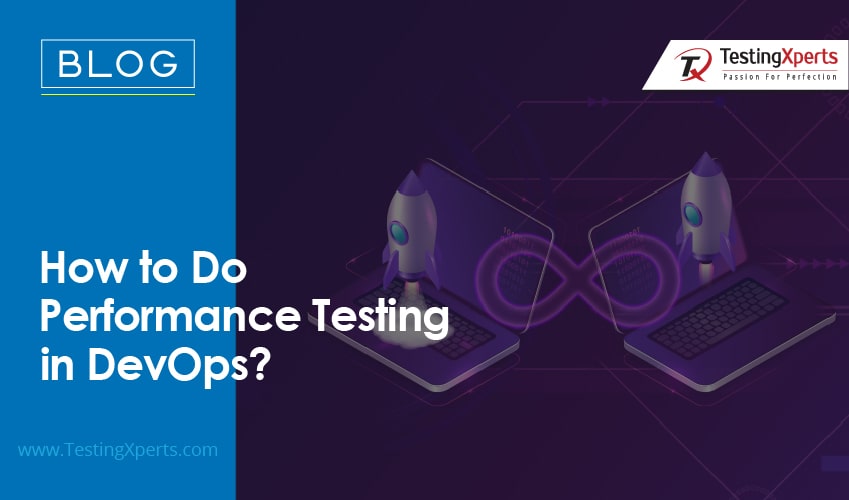
Every business needs high-performing and seamless applications (mobile & web) to increase user engagement and deliver a great customer experience (CX). Today, businesses continue to embrace DevOps to get faster releases and high-quality software that embeds continuous integration, continuous testing, and delivery. The DevOps continuous testing involves functional, performance, security, and other testing methods to ensure flawless, high-quality apps. Specifically, performance testing plays a critical role in improving the scalability, reliability, and robustness of the apps before they are released into the market.
- Software Performance Testing
- Some of the Use cases of Performance testing
- Benefits of performance testing
- Various types of Performance Testing
- An overview of performance testing in DevOps
- Performance testing in DevOps CI/CD pipeline
- Performance testing process overview
- Performance testing metrics to measure mobile app performance
- How is performance testing important for data migration and ETL testing?
- Significance of think time in performance testing
- An overview of automated performance testing tools
- Conclusion
Software Performance Testing

Performance testing is a non-functional software testing method performed to check the software’s speed, responsiveness, scalability, stability, and reliability. The primary aim of this testing method is to remove performance bottlenecks from the app/software and ensure seamless performance under all conditions such as varying user loads, fluctuating networks, varying network bandwidths, etc.
Some of the Use cases of Performance testing

• Checking app performance by simultaneously running multiple applications in the background
• Verifying app performance when multiple users login at the same time
• Checking app performance by suddenly increasing/decreasing user load
• Checking app performance under various types of networks, such as Wi-Fi, LAN, 3G, 4G, etc.
• Checking app responsiveness by taking into consideration the app response to user queries
Benefits of performance testing
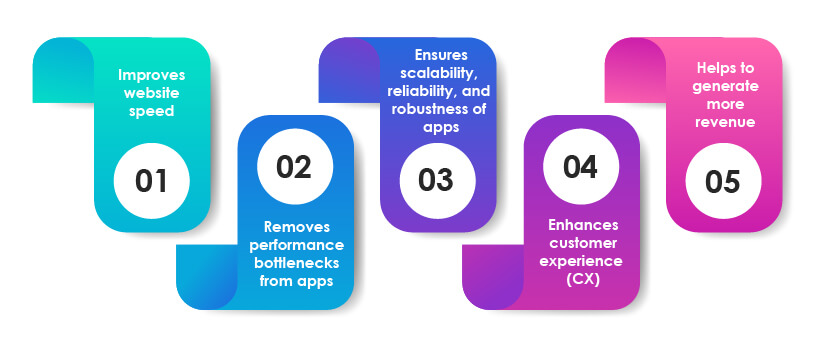
1. Improves website speed:
Common issues like broken images, content-related issues, frequent timeouts, etc., hamper the website speed. This non-functional testing method helps identify and resolve these issues, thus enhancing the website speed.
2. Removes performance bottlenecks from apps:
This software testing ensures the removal of critical bugs and performance bottlenecks from the software before it goes live.
3. Ensures scalability, reliability, and robustness of apps:
This testing type ensures that the software is scalable and can handle users even during peak loads. It ensures that the software performs well under unexpected situations like fluctuating networks, bandwidths, user load, etc. Thus, it ensures the software’s scalability, reliability, and robustness.
4. Enhances customer experience (CX):
End-users don’t prefer slow-loading apps and websites. This testing method helps in improving the app’s performance and speed, which ultimately enhances the CX.
5. Helps to generate more revenue:
It is known that end-users prefer apps with seamless performance. Better app performance will generate more revenue for businesses as users prefer to download such seamless apps, especially for eCommerce, telecom, and healthcare sector apps.
Various types of Performance Testing
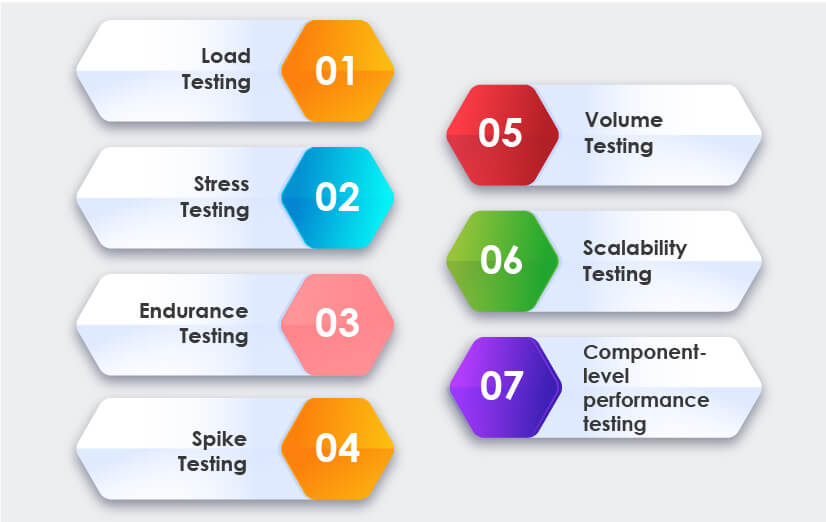
1. Load Testing:
Testers perform this testing by simulating the number of virtual users that might use the application. The principal aim of this testing method is to ensure that the application performs well under normal and peak user loads.
2. Stress Testing:
This testing technique helps identify the system’s breaking point when user load is increased beyond the expected peak.
3. Endurance Testing:
This testing helps identify any resource leakage in the system, while it is subjected to normal user load for an extended duration like 8 hours, 12 hours, 24 hours, or 48 hours, etc.
4. Spike Testing:
It is a subset of stress testing and checks the system’s behavior by suddenly varying the no. of users. This testing checks if the system can handle the variations in user load.
5. Volume Testing:
In this testing method, multiple data-intensive transactions are performed to validate how the system performs under such data volumes.
6. Scalability Testing:
This testing method determines the capability of the system to scale up in terms of user load, data volume, number of transactions, etc. The main aim of this testing method is to determine the peak point beyond which the system prevents more scaling.
7. Component-level performance testing:
An application comprises minor components that are the smallest parts of an application. In component-level performance testing, the individual components of the application are tested to ensure the effective performance of components in isolation. Later, all the app components are tested as a group to ensure a high-performing and fully integrated application. Further, these components are integrated, and finally, performance testing is executed after integration.
An overview of performance testing in DevOps

Businesses continue to embrace DevOps to get faster releases and high-quality in less time. This DevOps methodology promotes collaboration between teams to deliver faster and quality releases to the customer. The DevOps lifecycle includes various stages such as Continuous Integration (CI), Continuous Testing (CT), and Continuous Delivery (CD). Typically, to ensure the release of high-quality software in less time, performance testing in DevOps plays a critical role. Moreover, performance testing in DevOps is done by integrating continuous and automated performance testing in the continuous delivery pipeline. However, to take up performance and load testing in DevOps, a series of steps should be followed at each stage of the DevOps lifecycle.
Performance testing in DevOps CI/CD pipeline
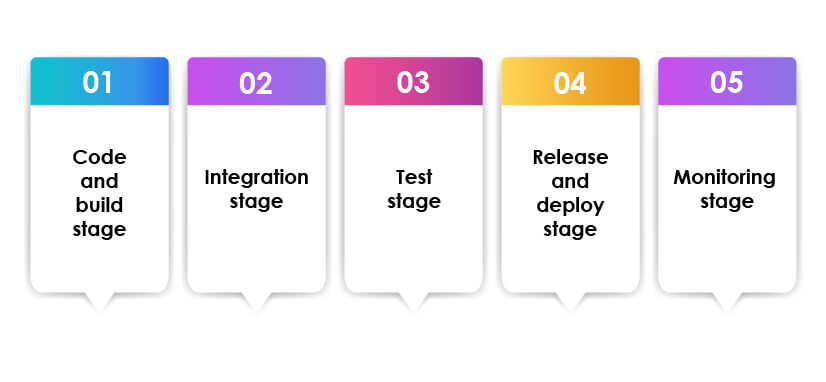
Performance testing in DevOps involves continuous performance evaluation at each DevOps CI/CD pipeline stage and ensures faster feedback loops for software improvement.
1. Code and build stage:
DevOps performance testing starts with continuous performance testing at the build stage, which involves unit performance testing. In this stage, the smallest unit of the software is checked to ensure they perform well in isolation.
2. Integration stage:
Once the unit performance testing is done, performance testing is done at the integration stage, where the smallest units of the software are integrated. The performance of these integrated units/modules is tested to ensure the effective performance of modules after integration.
3. Test stage:
During this stage, system-level performance testing is done to ensure the software performs well as expected. Once the system-level performance tests are passed, the software moves to the release and deploy stage.
4. Release and deploy stage:
During this stage, load testing and real user monitoring are performed to ensure that the software handles the user load effectively in the production environment.
5. Monitoring stage:
After the software reaches the monitoring stage, continuous performance monitoring is done, where various performance metrics are evaluated to determine areas that need improvement.
Performance testing process overview
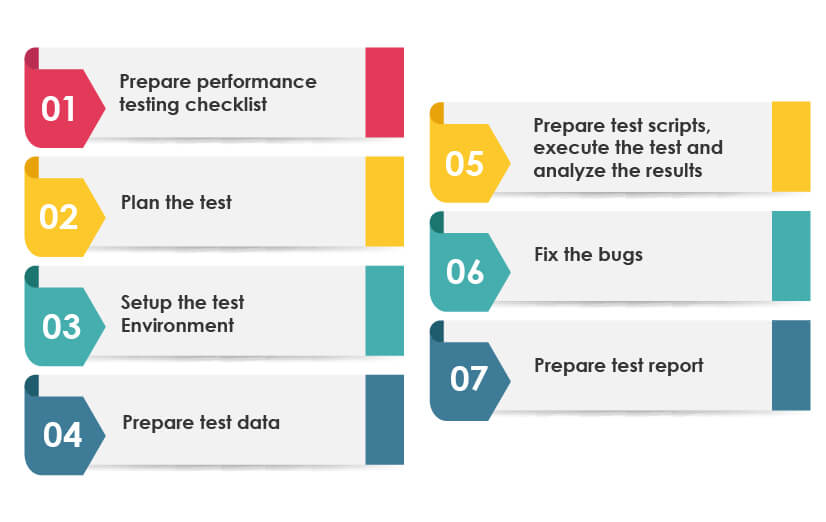
1. Prepare performance testing checklist:
Testers should prepare a checklist before starting the test. Performance testing checklist includes what is to be tested, pass/fail criteria, user scenarios, issues to be monitored, etc. While preparing the checklist, testers need to gather the client’s requirements.
2. Plan the test:
Prepare a test plan or test strategy which covers the aim and scope of testing, application architecture, environment details, testing tools, roles, responsibilities, etc.
3. Setup the test environment:
Testers need to set up the test environment. There are two types of test environments, on-premise, and on-cloud. The test environment should be chosen wisely, as the effectiveness of the testing process largely depends on the environment in which it is executed. Load generation environment should be configured to generate virtual load for load testing of the software.
4. Prepare test data:
To set up the test data, testers need to first extract test data, modify the data for testing the software, and generate enough test data to perform the tests.
5. Prepare test scripts, execute the test and analyze the results:
This is an important step that involves preparation of test scripts, execution of test cases, and analysis of test results to know whether it is pass or fail.
6. Fix the bugs:
The Dev team resolves all the bugs found during the testing process. Once all the bugs are fixed, the testing process is repeated to ensure defects are fixed.
7. Prepare test report:
Document all the test findings in one place and share the test report with all the stakeholders and project team.
Performance testing metrics to measure mobile app performance
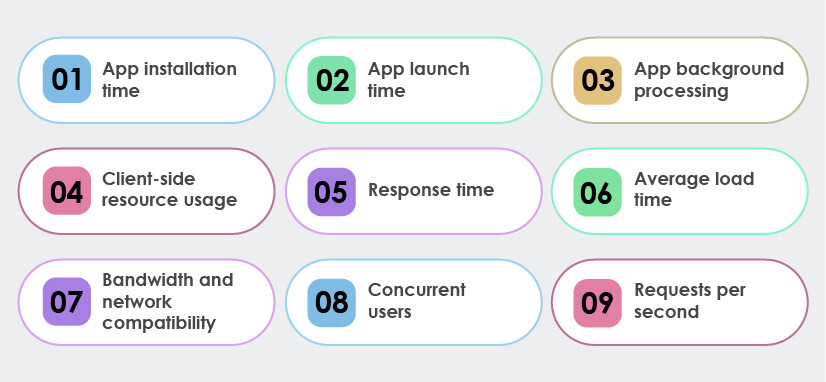
1. App installation time:
This metric gives the user a first impression of the app. This metric measures the app installation time and how it can be improved.
2. App launch time:
App launch time or app start time is another important metric that must be checked in an application. Ideally, it should not be more than 1 to 2 seconds.
3. App background processing:
It is essential to ensure that app performance remains unaffected when multiple apps run parallelly. It is essential to ensure that no data loss should happen when the app runs in the background and is retrieved.
4. Client-side resource usage:
An app should not consume excess memory and must not heat the device, especially when it runs in the background. Thus, checking an app’s CPU usage and memory during its execution is essential.
5. Response time:
This metric measures the time is taken by an app to respond to a given input. Faster response time ensures less wait time and high performance of the app.
6. Average load time:
Load time of app/website and page load time is very important for users and businesses. Faster loading time or speed ensures better performance of an app.
7. Bandwidth and network compatibility:
Varying bandwidth and fluctuating networks affect the app loading time. However, to ensure effective app performance, it is essential to perform load testing of an app with minimal bandwidth and different network types and connections such as 3G, 4G, 5G, Wi-FI, etc.
8. Concurrent users:
This metric measures how many virtual users are active or accessing the app at a given point in time. The number of users using the app directly impacts the app’s performance.
9. Requests per second:
It is the measure of how many requests by second the server can handle without degrading performance or resulting in error.
How is performance testing important for data migration and ETL testing?
Data migration is a complex but essential process for every business. Effective data migration helps businesses ensure better data availability, reduced cost, improved performance, and more. However, while migrating data from various sources to a new system, it is essential to ensure that the new system’s performance remains unaffected after migration. This is where the need for performance testing during data migration comes into the picture. In this testing type, various performance tests are executed on the system before and after migration to ensure the new system’s performance is not degraded post-migration.
Performance and load testing play a vital role in the Extract/Transform/Load (ETL) process. The data is extracted from various sources during the ETL process, transformed into a consistent data type, and then loaded into the data warehouse or target system. Performance testing in ETL is done to ensure that the ETL system can handle a high volume of transactions. Performance tests in ETL also verify the efficiency of the ETL system by determining the actual time taken by the system to process data. The lesser the data processing time, the higher is the efficiency.
Significance of think time in performance testing

Think time is the time difference between each action performed by the user. When users visit a website, they take some time to think and take action. The difference or the time gap between each action performed by the user is known as think time.
For example, suppose a user visits an eCommerce website. The user clicks on the products tab, selects the product, reads the description, and adds the product to the cart. The time spent between clicking on the product tab to clicking on the add to cart tab is considered think time.
Think time plays a very crucial role, as it represents the user’s actual behavior in the system. A user never does all actions like login, search product, add to cart, payment, log out in one go. The users take some time to complete all actions. Therefore, it is necessary to introduce think time in this non-functional software testing technique to create a real-world scenario in the testing environment.
Another reason to introduce think time in performance and load testing is that suppose if a tester executes software testing giving multiple requests with no pause, it will fail the server. The server also needs time to process requests and give the result. Therefore, it is essential to consider think time in performance and load testing.
An overview of automated performance testing tools
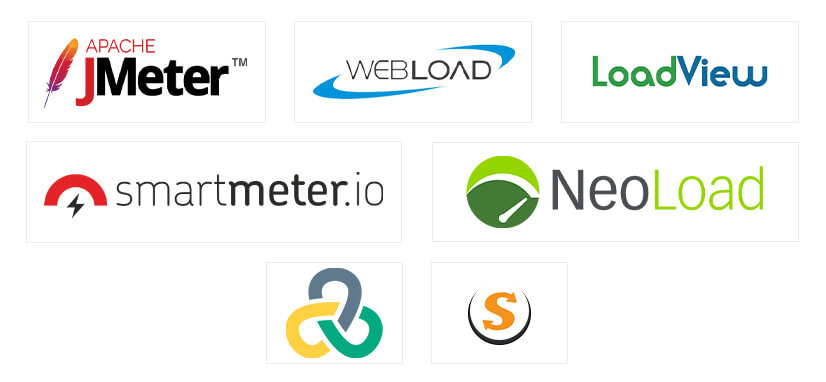
1. Apache JMeter:
It is an open-source tool that helps to analyze and measure the performance of a range of web applications. This tool supports various protocols, such as HTTP, HTTPS, XML, SOAP, Java-based protocols, etc. This non-functional software testing tool requires less scripting effort as compared to other tools and has simple charts/graphs that can be used for analyzing key load-related statistics and resource usage.
2. WebLOAD:
It is an enterprise-scale load testing tool that is used for web and mobile load testing. This tool comes with a good number of features and functionalities, such as Load Generation Console, Analytics Dashboard, and comprehensive IDE.
3. Stress Stimulus:
This tool is used to perform load testing of web apps, mobile apps, and enterprise apps. Stress stimulus supports on-premise or cloud load testing and works well with Fiddler. This tool comes with an end-to-end test wizard that eases the performance testing of mobile and web apps.
4. io:
It is a multiplatform performance and load testing tool. This tool allows adding performance testing into the continuous integration process, real-time monitoring of the test environment, and analyzing test results on multiple machines.
5. NeoLoad:
It is a continuous performance testing tool for desktop and mobile apps. This tool comes with great features like scriptless test creation, GUI-driven design, automated parameterization, etc. Neoload can be easily integrated with CI tools, and it allows real-time identification and removal of performance bottlenecks.
6. Load Runner:
It is the most widely used tool to test applications and measure system behavior and performance under varying loads. This tool is used to simulate thousands of concurrent users and record the variations in the system performance. This testing tool supports all advanced technologies like Ajax, Flex, HTML5.0, Java, SOAP, Citrix, along with all other legacy technologies.
7. LoadView:
It is used for cloud-based load testing, and it helps DevOps teams to test websites, web apps, and application programming interfaces (APIs) with thousands of concurrent users. This tool simulates API calls, validates API responses, and verifies the most important SLA requirements. The agile and DevOps teams can test their website’s UX under load, verify performance and identify various bottlenecks within the applications.
Conclusion
Performance testing is an essential element that determines the success of an application in DevOps processes. A high-performing app is the need of the hour for businesses and the low performance of the app can affect the brand reputation and even the CX. Hence, a well-developed performance testing method and proper automated tools should be leveraged to get high-performing and scalable apps. Thus, enterprises should leverage end-to-end performance testing from a next-gen QA and independent software testing services provider for high-performing software and faster time to market.
Discover more
Get in Touch
Stay Updated
Subscribe for more info




